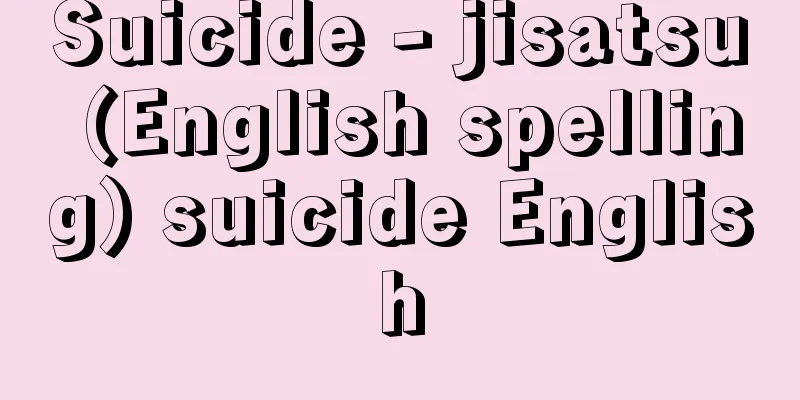Suicide - jisatsu (English spelling) suicide English

|
It is an act of voluntarily and intentionally taking one's own life, and is also called self-murder or suicide. The word "suicide" in English and French comes from the Latin compound word sui (oneself) and caedō (to kill). Suicide has been common since ancient societies, and in Japan, institutionalized suicide (junshi) and samurai seppuku (suicide punishment) are well known. In recent years, "honorable suicide" and love suicide (agreed double suicide) have drastically decreased in Japan, but parent-child double suicides, which are unique to Japan, continue to occur. Statistics show that suicides in Japan during the 10 years from 1989 (Heisei 1) to 1998 accounted for 2.5% of all deaths, with a male-female ratio of about 10 to 5. If we compare this with the 10 years from the 1970s to the 1980s, where suicides during that decade accounted for 2% of all deaths, we can see that the ratio has increased. Moreover, the ratio increased further to 3.4% in 1998. The total number of suicides in 2007 was 33,093, a 2.9% increase from the previous year, and has fluctuated between 31,000 and 34,000 since 1998 (Vital Statistics, compiled by the Ministry of Health, Labor and Welfare). The means of suicide vary according to national character and the availability of the means. This is why firearms are more common in the United States. In Japan, hanging is the most common and always ranks first. Jumping from high places is also common, and jumping from high-rise buildings in particular has been increasing rapidly. Suicides by poisoning have generally decreased due to legal restrictions on hypnotics and pesticides since 1961, but suicides by herbicide-type pesticides have always been in the top five. In the 1990s, suicides by therapeutic analgesics and hypnotics and hypnotics purchased from overseas over the Internet also became common. Gas suicides have decreased slightly due to legal restrictions on the carbon monoxide gas content of city gas, but suicides by other gases and vapors are still common and rank in the top five. Recently, there have been cases of group suicides announced over the Internet. Generally, men choose hanging (especially the elderly) or jumping, while women choose hanging or drowning, both of which are aggressive actions. Death from a suicidal attempt can occur in a variety of ways, from direct death from blood loss due to a cut in the carotid artery to indirect death from acute peritonitis secondary to an abdominal incision. The most common cause of suicide is health problems (disease, physical disability, old age, physical deterioration, etc.), followed by lifestyle and economic problems. Since the 1990s, there has been a gradual increase in corporate suicides related to work-related issues, and suicides caused by bullying, school refusal, and domestic violence. Even in people who were thought to be healthy before suicide, postmortem autopsies may reveal abnormal illnesses, leading to the presumption that illness was the cause of the suicide. When examining a body that has died in an unnatural way, if there is a suicide note and the means, method, and circumstances are consistent with suicide, it is considered suicide, but there may be circumstances in which the person was forced to commit suicide and left a suicide note. Suicide is not a crime, but if you encourage someone to commit suicide (incitement to suicide) or help them (assistance in suicide), you will be charged with contributing to suicide. Also, if the person who initiated the double suicide or the parent in a double suicide survives, they will be charged with murder. [Akiko Sawaguchi] It is necessary to distinguish between suicides that take place in accordance with certain systems or customs, and acts similar to suicide that are committed due to disorders of consciousness or intelligence, and there are many cases in which these acts can be confused with accidental death or homicide. The philosopher Seneca once said that "suicide is a human characteristic," but from ancient Plato to modern Camus, there have been many debates about the act of suicide. The study of suicide is called suicidology. [Hiroaki Iwai and Masaaki Takahara] Suicide in the world and JapanThe incidence of suicide varies depending on the era and region, but looking at trends by country from the beginning of the 20th century to the present, the countries with the highest suicide rates (per 100,000 population) from 1901 to 1955 were Japan, Switzerland, Germany, France, and Sweden, with Japan ranking 2nd to 5th. In 1899 (Meiji 32), when suicide statistics began to be kept in Japan, the suicide rate was 13.7, and it increased from the end of the Meiji period to the beginning of the Taisho period, exceeding 20.0 between 1925 and 1937 (Taisho 14 to Showa 12). The highest suicide rate before and during the war was 22.2 in 1932, and the lowest was 12.1 in 1943 during the war. In particular, from 1955 to 1960, Japan's suicide rate was the highest in the world, with the first peak being 25.7 in 1958, a year known as the bottom of the economy. After that, the rate continued to decline, reaching a postwar low of 14.2 in 1967 during the period of high economic growth. In 1970, the suicide rates of Northern and Eastern European countries such as Hungary, Czechoslovakia, Finland, and Sweden were high, and Japan's suicide rate of 15.3 was ninth. However, in the 1980s, suicides began to increase again, exceeding 19.0 for five years from 1983 to 1987, and reaching a second peak of 21.2 in 1986. Furthermore, the number of suicides suddenly increased to the 30,000 range in 1998 (Heisei 10), and the 10 years following this saw a period of high suicide rates, with the third peak being in 1999, with 33,048 suicides (26.1), the highest number and rate in history. In 2007, the number of suicides was 30,777, and the suicide rate was 24.4. In addition, the countries with the highest suicide rates in a 2004 survey by the World Health Organization (WHO) were Lithuania, Russia, Belarus, Ukraine, and Kazakhstan, with Japan ranking 10th. [Hiroaki Iwai and Masaaki Takahara] Age and GenderIn Japan, the number of suicides in the 0-19 age group was 382 males and 226 females in 2005, and 395 males and 228 females in 2006, which is considerably lower than other age groups. However, the high suicide rate among young people in the past is a unique phenomenon in Japan even from an international perspective, and was also the cause of the high suicide rate during the first peak period. For example, in 1955 (Showa 30), the number of suicides in the 15-24 age group was 8,231, accounting for 36% of the total, and the suicide rate of the 20-24 age group was 65.4, and during this period, the suicide rate drew an N-shaped curve with high peaks in adolescence and old age ( , ). After that, the suicide rate among young people dropped sharply from the period of high economic growth, and in 1985, the number of suicides in the 15-24 age group was 1,630, accounting for only 7.0% of the total. The suicide rate during this second peak period is said to be of the Western type, which shows a straight line that rises to the right with age. By the way, looking at the suicide rate (overall 23.7) in 2006 (Heisei 18) by age group, the highest suicide rate was 55-64 years old at 35.3, 45-54 years old at 32.9, 75 years old and over at 29.6, 65-74 years old at 28.8, and 35-44 years old at 26.0. Excluding the high suicide rate of men aged 85 years old and over, the highest suicide rate was 58.6 for men aged 55-59. The suicide rate during this period can be seen as moving to a new N-shaped curve with a high peak in middle-aged men. In particular, of the 8,472 increase in the number of suicides in 1998, when the number of suicides suddenly increased to the 30,000 range, 78% were men, and the 50-64 age group increased by 44%, with the overwhelming majority being unorganized workers, unemployed people, and unemployed people. The suicide rate has been consistently increasing with age among the elderly, but the rate is gradually weakening. In the case of the elderly, suicidal thoughts tend to increase due to illness or the death or separation of a spouse. For this reason, suicides among the elderly are primarily caused by loneliness and loss due to "weakening of group integration" caused by weakening ties with the next generation due to changes in the industrial structure and shrinking family and community functions. In 2007, seven prefectures - Aomori, Iwate, Akita, Niigata, Shimane, Kochi, and Miyazaki - had suicide rates above 30.0, and all of these prefectures have high suicide rates among the elderly, which is thought to be due to the poverty and depopulation of rural areas. In addition, when comparing men and women, the suicide rate is higher for men, regardless of whether they are from the East or the West. Japan is no exception, but compared to other countries, the suicide rate of Japanese women is relatively high. In particular, from the Meiji period until before World War II, the ratio of women to men was around 60, and after the war it rose to 81 in 1970 (Showa 45), but then fell, dropping to about 41 in 2006 (Heisei 18). Looking at the suicide rate of women in the same year (overall 13.2) by age group, it was 12-15 for those aged 20-59, 16-19 for those aged 60-79, and generally over 20.0 for those aged 80 or older, showing a tendency to rise with age, and the suicide rate is still high by international standards. The high suicide rate of Japanese women is thought to be due to the fact that, despite the rise in the ego of Japanese women and their advancement in society, gender consciousness and pre-modern human relationships in the family and community remain strong, preventing women from becoming independent. [Hiroaki Iwai and Masaaki Takahara] Causes and motives of suicideHenry Morselli, a French psychiatrist known as a classic researcher of suicide, classified the motives of suicide into 10 categories: mental illness, family hardship, illness, passion, immorality, family discord, financial disappointment, regret, disappointment, and unknown. The Japanese National Police Agency classifies motives into eight categories: family problems, health problems, economic and lifestyle problems, work problems, gender problems, school problems, other, and unknown. The causes of suicide have been debated by many scholars. Philosopher Schopenhauer saw in suicide a strong will to live, and saw it as the result of despair when one recognizes the goal of life but judges it to be impossible to achieve. Psychoanalyst Freud hypothesized the death instinct in opposition to the life instinct, and interpreted suicide as an act of complete liberation from tension and effort, aiming to return to a fundamental, inorganic state. Furthermore, from a psychiatric standpoint, the relationship with depression, schizophrenia, hysteria, etc. is an issue. American psychiatrist GM Davidson pointed out that the mental state at the time of suicide is a narrowing of the conscious field caused by the loss of life goals, which leads to a decline in the ability to regulate. Other common causes cited by psychiatrists and psychologists include a lack of tolerance for failure, escapism, a desire for rest, a tendency to punish oneself, a desire for revenge or aggression, a desire to show oneself off, and a desire to maintain fame. From a religious perspective, the Japanese view of life and death is also an issue. There is a tradition of belittling death rather than surviving, and it is said that the Buddhist ideas of Enri Edo (a world of despair) and Gongu Jodo (a world of pure joy) have also had an influence. The tendency to glorify and romanticize death can be seen in the ancient works of Chikamatsu Monzaemon, such as his double suicide stories, and in the Meiji period and after, in the praise and appreciation of suicide in such figures as Fujimura Misao, Matsui Sumako, Akutagawa Ryunosuke, Dazai Osamu, and Haraguchi Tozo. However, this tendency in thought is becoming less and less evident as times change. From an economic point of view, the relationship between poverty and suicide is an issue. It is generally said that in foreign countries, suicide is more common among people with high and low incomes. British sociologist Peter Sainsbury argued in a London survey that it is difficult to find a simple correlation between suicide and poverty. In Japan, psychiatrist Takeshi Ohara (1930- ) pointed out that there are more suicides among the unemployed and those with unstable jobs, and sociologist Hisao Naka (1927-2005) pointed out that the suicide rate is low among the upper classes and high among the lower classes, and both emphasized the issue of poverty. Demographer Ayanori Okazaki (1895-1979) analyzed suicide and economic cycles using the wholesale price index from 1900 to 1960 (Meiji 33 to Showa 35), and stated that there are five periods in which recessions and increases in suicides, and booms and decreases in suicides are correlated, with only one period that does not match this (booms and increases in suicides). Naka also analyzed the unemployment rate and suicide rate from 1948 to 1958 and pointed out that there is a clear correlation between the two. In general, suicide trends in Japan tend to be strongly influenced by economic fluctuations, and the fact that there is a particularly high correlation with the unemployment rate is clear when we look at the changes in both after that. The suicide rate was low during the period of high economic growth from the 1960s to the early 1970s, but rose along with the rise in the unemployment rate during the subsequent period of low growth. The suicide rate then fell along with the decline in the unemployment rate from around 1990 during the bubble economy, but since 1998 (Heisei 10), when the Heisei Great Recession became serious and the unemployment rate exceeded 4%, the suicide rate has risen sharply again. In particular, the high suicide rate among middle-aged people during this period is thought to be largely due to excessive work due to restructuring and rationalization, and an increase in feelings of stagnation and anxiety. However, since there are countries with higher unemployment rates than Japan but lower suicide rates, other social and psychological factors must also be considered when analyzing suicide in Japan. One factor that should be noted is the single Japanese value that "work is a virtue," which is expressed as an attitude of excessively identifying oneself with one's professional role (role narcissism). [Hiroaki Iwai and Masaaki Takahara] Types of suicideIn relation to the causes of suicide, it has also been categorized from various angles. For example, French sociologist Durkheim, who wrote "Suicide" (1897), distinguished suicide into egoistic (egoistic), group-oriented (altruistic), anomic (unregulated), and fatalistic suicide, and said that in reality, there are also mixtures of these types of suicide. In addition, Japanese psychologist Sonohara Taro (1909-82) classified suicide into defensive suicide, punitive suicide, aggressive suicide, sacrificial suicide, ecstasy suicide, and aesthetic suicide. There are various other classifications as well. Incidentally, double suicides are considered a Japanese tradition, but in the case of mother-son (father-son) double suicides, they are murder plus suicide, rather than a case of multiple suicides. Approximately one-fifth of people leave a will after a suicide or double suicide, but these can be in the form of a memoir, an apology, a report, an aphorism, or a poem, and can also include defenses or embellishments, so they do not necessarily clearly indicate the cause. [Hiroaki Iwai and Masaaki Takahara] Suicide preventionIt is said that before committing suicide, people unconsciously cry for help, and it is important to recognize these warning signs in order to prevent suicide. These include verbal signs such as "There's no point in living" or "I want to go far away," and behavioral signs such as suddenly going quiet or getting your affairs in order. The Samaritans, a welfare service run by the "Lifeline" service aimed at preventing suicide, was started in 1953 by London priest C. Varah, and has been actively operating in Japan since 1971 (Showa 46). [Hiroaki Iwai and Masaaki Takahara] "Social Statistical Study of Suicide" by Okazaki Fumiyoshi (1960, Nippon Hyoronsha)" ▽ "Suicide in Japan" by Ohara Takeshiro (1965, Seishin Shobo)" ▽ "Suicidology" by Inamura Hiroshi (1977, University of Tokyo Press)" ▽ "Child Suicide" by Inamura Hiroshi (1978, University of Tokyo Press)" ▽ "Suicide and Culture" by Fuse Toyomasa (1985, Shinchosha)" ▽ "Suicide" by E. Durkheim, translated by Miyajima Takashi (Chuko Bunko)" ▽ "Psychoanalysis of Suicide" by Takahashi Yoshitomo (1994, Seiwa Shoten)" ▽ "Living and Dying - Why Do People Commit Suicide" by Ohara Takeshiro (1996, Asahi Shimbun)" ▽ "Life and Death Considered from Psychiatry" by Takahashi Yoshitomo (1997, Kongo Shuppan)" ▽ "Overwork Suicide" by Hiroshi Kawato (Iwanami Shinsho)" ▽ "Trends in National Health" (2008), edited and published by the Health Statistics Association [References] | | | | | | | Double | | | |The figure shows the ratio per 100,000 population. Note: Source: Ministry of Health, Labor and Welfare "Vital Statistics" (Health and Welfare Statistics Association "National Health Trends 2008") ©Shogakukan Changes in suicide mortality rates by age group (male) [Figure... The figure shows the ratio per 100,000 population. Note: Source: Ministry of Health, Labor and Welfare "Vital Statistics" (Health and Welfare Statistics Association "National Health Trends 2008") ©Shogakukan Changes in suicide mortality rates by age group (female) [Figure... Source: Shogakukan Encyclopedia Nipponica About Encyclopedia Nipponica Information | Legend |
|
自分の生命を自発的、意図的に奪う行為で、自己殺人、自害ともいう。英、仏語のsuicideの語源はラテン語で、sui(自らを)とcaedō(殺す)の合成語である。自殺行為は古代社会から普遍的にみられたもので、日本でも、古くは制度的な自殺(殉死)や武士の切腹(自殺刑)が知られている。近年、日本では「名誉ある自殺」や情死(合意心中)は激減しているが、日本特有な親子心中は後を絶たない。統計からみると、1989年(平成1)から1998年までの10年間の日本における自殺は全死亡の2.5%を占め、男女比は約10対5である。1970年代から1980年代の10年間と比較してみると、その10年間の自殺は全死亡の2%であったから、比率は高まっていることがわかる。しかも、1998年には3.4%と比率をさらに高めている。2007年における自殺者総数は3万3093人で、前年に比べ2.9%増加しており、1998年以降は3万1000~3万4000人の間で推移している(厚生労働省編『人口動態統計』)。 自殺手段は国民性や入手しやすい手段の差によって異なる。アメリカでは銃器による自殺が多いのもこうした理由によっている。日本では縊首(いしゅ)が多く、つねに第1位である。高所からの飛び降りも多く、とくに、高層建物からの飛び降りは急増している。服毒自殺は、1961年(昭和36)以降の催眠剤や農薬の法的規制で全般的に減少しているが、除草剤系農薬による自殺はつねに上位5位以内に入っている。1990年代になると治療用鎮痛・催眠剤やインターネットで外国から購入した催眠剤による自殺もみられる。都市ガスの一酸化炭素ガス含有量の法的規制により、ガス自殺はやや減少したが、その他のガスや蒸気による自殺は依然として多く、上位5位以内に入っている。最近ではインターネット上で呼びかけ集団自殺を行う例もみられる。一般に男性は縊首(とくに老人)や飛び降り、女性は縊首、入水といった手段を選ぶことが多く、いずれも積極的行為を選ぶ。自殺行為の結果、死ぬまでの経過はさまざまである。頸動脈(けいどうみゃく)切創による失血死のように直接的なこともあり、腹部切創後に二次的に急性腹膜炎を起こして死亡するといった間接的なこともある。 自殺の背景としては健康問題(病気、身体障害、老衰、身体的劣等など)がもっとも多く、ついで生活・経済問題である。1990年代に入ると、勤務問題がかかわる企業自殺、いじめ・不登校(登校拒否)・家庭内暴力を背景にした自殺が漸増している。また自殺前、いちおう健康とみられていた者でも、死後の剖検(ぼうけん)によって疾病異常が発見されて、病苦が自殺の背景にあったと推量されることがある。いわゆる変死体を検案する際に、遺書が存在し、その手段、方法、状況が自殺と矛盾がなければ自殺を裏づけることになるが、なかには、自殺を強要し、遺書を残させる状況もありうる。自殺は犯罪ではないが、他人に自殺を唆したり(自殺教唆)、その手助け(自殺幇助(ほうじょ))をすれば自殺関与罪となる。また、無理心中の発案者や親子心中の親が生き残れば殺人罪に問われる。 [澤口彰子] なお、一定の制度や習慣などに従って行われる自殺をはじめ、意識や知能の障害によって自殺類似の行為が行われることもあり、また実際に事故死や他殺と紛らわしい場合も多いので、これらを区別する必要がある。 かつて哲学者セネカは「自殺は人間の特徴である」と述べたが、古代のプラトンから現代のカミュに至るまで、自殺という行為をめぐって多くの論議がなされてきた。自殺に関する研究を自殺学suicidologyという。 [岩井弘融・高原正興] 世界と日本の自殺自殺の発生は時代や地域などによってさまざまに変化するが、20世紀初頭から現在までの動向を各国別にみると、1901年から1955年までを通じて自殺率(人口10万対)が高かったのは、日本、スイス、ドイツ、フランス、スウェーデンなどであり、日本は2~5位であった。日本の自殺統計が始まった1899年(明治32)の自殺率は13.7であり、明治末期から大正初期にかけて増加し、1925~1937年(大正14~昭和12)の間は20.0を上回っており、戦前・戦中期の最高は1932年の22.2、最低は戦中の1943年の12.1であった。とくに、1955年から1960年までは日本の自殺率は世界一で、なべ底景気といわれた1958年の25.7が第1のピークであった。そして、その後は減少傾向を続けて、高度経済成長期の1967年に14.2の戦後最低を記録し、1970年にはハンガリー、チェコスロバキア、フィンランド、スウェーデンなどの北欧・東欧諸国の自殺率が高く、日本の自殺率15.3は第9位であった。しかし、1980年代には再び自殺増加期に転じて、1983年から1987年までの5年間は自殺率が19.0を上回り、1986年の21.2で第2のピークを形成した。さらに、自殺者数が一挙に3万人台に増加した1998年(平成10)以降の10年間は、史上最多の自殺者数と自殺率を記録した1999年の3万3048人(26.1)を第3のピークとする自殺多発期を形成している。なお、2007年には、自殺者数3万0777人、自殺率24.4を記録している。また、世界保健機関(WHO)の2004年時調査における自殺率の高い国の順位は、リトアニア、ロシア、ベラルーシ、ウクライナ、カザフスタンであり、日本は第10位であった。 [岩井弘融・高原正興] 年齢と性日本の0~19歳の年齢層の自殺者数は、2005年に男382人、女226人、2006年に男395人、女228人を記録しており、他の年齢層に比べてかなり少ない。しかし、過去に青年層の自殺が多かったことは国際的にみても日本独特の現象であり、第1のピーク期における高い自殺率の原因でもあった。たとえば1955年(昭和30)には、15~24歳の年齢層の自殺者数8231人は総数の36%を占めて、20~24歳の年齢層の自殺率は65.4を記録しており、この時期は青年期と高齢期に自殺率が高い山を示すN字型曲線を描いていた(、)。その後、青年層の自殺率は高度経済成長期から急激に低下し、1985年には15~24歳の年齢層の自殺者数1630人が総数の7.0%を占めるにすぎなくなった。この第2のピーク期の自殺率は、加齢とともに右上がりの直線を示す欧米型といわれている。 ところで、第3のピーク期の2006年(平成18)における自殺率(全体23.7)を年齢層別に高い順で見ると、55~64歳35.3、45~54歳32.9、75歳以上29.6、65~74歳28.8、35~44歳26.0であり、85歳以上の男性の高い自殺率を除けば、55~59歳の男性の自殺率58.6が最高値を示している。そして、この時期の自殺率は、男性中年層において高い山を形成する新N字型曲線に移行しているとみることができる。とくに、自殺者数が一挙に3万人台に増えた1998年の増加数8472人のうち男性が78%を占め、50~64歳の年齢層が44%も増加し、未組織労働者、無職者、失業者が圧倒的に多いと報告されている。なお、高齢者層では加齢とともに自殺率が一貫して上昇しているが、その度合いは次第に弱まってきている。 高齢者の場合は、病苦や、配偶者などとの死別・離別によって、希死念慮がつのる傾向がある。そのために、高齢者の自殺は、産業構造の変化によって次世代世帯との紐帯が弱まり、家族・地域の機能の縮小といった「集団の統合の弱まり」による孤独と喪失を基調にしている。2007年に自殺率が30.0を超えた県は、青森・岩手・秋田・新潟・島根・高知・宮崎の7県であるが、これらの各県はいずれも高齢者層の自殺率が高く、農村の貧困と過疎が影響を与えていると考えられる。 また、男性と女性を比較すると、洋の東西を問わず、男性の自殺率が高い。日本もその例外ではないが、外国と比較すると、日本の女性の自殺率は相対的に高い。とくに、明治期から第二次世界大戦前までは、男性100に対して女性は60前後の割合であり、戦後は上昇して1970年(昭和45)には81にまで達したが、その後は下降して、2006年(平成18)には約41まで低下している。同年の女性の自殺率(全体13.2)を年齢層別にみると、20~59歳では12~15台、60~79歳では16~19台、80歳以上で概ね20.0を超えており、加齢とともに上昇する傾向にあり、その自殺率は国際的には依然として高い方である。このような日本の女性の自殺率の高さについては、日本の女性の自我の高まりや社会進出にもかかわらず、ジェンダー意識や家族・地域の前近代的な人間関係が依然として強く、女性の自立を妨げているためと考えられる。 [岩井弘融・高原正興] 自殺の原因・動機自殺の古典的な研究者として知られるフランスの精神医学者モルセッリHenry Morselliは、自殺の動機として、精神病、家庭困窮、病苦、激情、不徳、家庭不和、財政的失望、後悔廉恥、失望、不明の10分類を行った。日本の警察庁の動機分類は、家庭問題、健康問題、経済・生活問題、勤務問題、男女問題、学校問題、その他、不明の8つになっている。 自殺の原因については、これまで多くの学者によって論じられてきた。哲学者ショーペンハウアーは、自殺のなかに強い生への意志をみて、それが生の目標を認識しながらも達成不可能と判断したときに絶望する結果とみた。精神分析学者のフロイトは、生の本能に対する死の本能を想定し、緊張と努力から完全に解放されて、根源的・無機的状態への回帰を目ざす行為として自殺を解釈した。 さらに、精神医学の立場からは、うつ病、統合失調症、ヒステリーなどとの関係が問題とされている。アメリカの精神医学者デビッドソンG. M. Davidsonは、自殺時の精神状態として、生活目標の喪失によって意識野の狭窄(きょうさく)が生じ、調整機能が低下することを指摘した。そのほか一般に精神医学者や心理学者によって、失敗への耐性不足、現実逃避、休息願望、内罰傾向、復讐(ふくしゅう)・攻撃願望、自己顕示願望、名声保持願望などがあげられることが多い。 宗教的な観点からは、日本人の死生観なども問題にされる。生き抜くということよりも死を軽んずる伝統があり、また、厭離穢土(えんりえど)・欣求浄土(ごんぐじょうど)の仏教思想も影響を与えてきたといわれる。死を美化し、ロマンチックなものとみる傾向は、古くは近松門左衛門(もんざえもん)の心中物、明治以後では藤村操(みさお)、松井須磨子(すまこ)、芥川龍之介(あくたがわりゅうのすけ)、太宰治(だざいおさむ)、原口統三などの自殺に対する賛美や評価に至るまでみられてきた。しかし、このような思想傾向は、時代の変化とともにほとんどみられなくなってきている。 経済的な観点からは、貧困と自殺との関係が問題にされる。一般には、外国では高所得者と低所得者に自殺が多いといわれている。イギリスの社会学者セーンスバリーPeter Sainsburyはロンドンの調査において、自殺と貧困との単純な相関関係は認めがたいと主張した。これに対し日本では、精神医学者の大原健士郎(1930― )が、無職業者、職業不安定者に自殺が多いこと、社会学者の中久郎(なかひさお)(1927―2005)が、上位階層の自殺率は低く、低階層では高いことを指摘して、いずれも貧困問題を重視している。人口学者の岡崎文規(あやのり)(1895―1979)は、1900~1960年(明治33~昭和35)の卸売物価指数を用いて自殺と経済周期に関する分析を行い、不況と自殺の増加、好況と自殺の減少とが相関する五つの時期があり、ただ一つこれに合致しない時期(好況で自殺が増大)のあることも述べている。また中は、1948~1958年について完全失業率と自殺率を分析して、両者には明らかな相関関係があることを指摘している。 一般的には、日本の自殺の動向は経済変動に左右される傾向が強く、とくに失業率と高い相関関係にあることは、その後の双方の変化をみても明らかである。1960年代から1970年代初期の高度経済成長期には自殺率が低く、その後の低成長期における失業率の上昇とともに自殺率も上昇した。そして、バブル経済期の1990年前後からの失業率の低下とともに自殺率も低下したが、平成大不況が深刻になって失業率が4%を超えた1998年(平10)からは、ふたたび自殺率が急激に上昇している。とくに、この時期に中年層の自殺率が高いことは、リストラ、合理化による過重労働、閉塞感や不安感の増大によるところが大きいと推測される。しかし、日本よりも失業率が高いのに自殺率が低い国もあるので、日本の自殺の分析にはその他の社会心理的要因も考える必要がある。その要因の中で注目すべきことは「働くことが美徳」という単一の日本的な価値観であり、それは自己を職業的役割に過度に同一化する態度(役割自己愛)として表れる。 [岩井弘融・高原正興] 自殺の類型自殺の原因と関連して、その類型化も各方面から行われている。たとえば、『自殺論』(1897)を著したフランスの社会学者デュルケームは、自己本位的(利己的)égöiste自殺、集団本位的(愛他的)altruiste自殺、アノミー的(無規制的)anomique自殺、および宿命的fataliste自殺に分け、現実の自殺にはこれらの混合型もあるとした。また、日本では心理学者園原(そのはら)太郎(1909―82)が、防衛的自殺、懲罰的自殺、攻撃的自殺、犠牲的自殺、エクスタシー自殺、耽美(たんび)的自殺に分類した。そのほかにもさまざまな分類がある。 なお、心中は日本の伝統とされるが、そのうち母子(父子)心中のごときは、複数自殺というよりもむしろ、他殺プラス自殺である。自殺または心中に際して遺書を残すのはおおよそ全体の5分の1くらいであるが、手記型、詫言(わびごと)型、報告書型、警句型、詩歌型などがあり、弁護や虚飾もあるので、かならずしも原因を明らかに示すものではない。 [岩井弘融・高原正興] 自殺の防止自殺者はその行動前に無意識的に「助けの声」cry for helpをあげているといわれ、その前兆をとらえることが防止上も重要とされる。「生きていてもしようがない」とか「遠くへ行きたい」などともらす言語的兆候、また、急に黙ったり、身辺整理をするなどの行動的兆候の両面がある。 自殺防止を目的とした「いのちの電話」の福祉サービス(The Samaritans)は1953年、ロンドンの司祭バラーC. Varahによって始められ、日本でも1971年(昭和46)から活発な活動をしている。 [岩井弘融・高原正興] 『岡崎文規著『自殺の社会統計的研究』(1960・日本評論社)』▽『大原健士郎著『日本の自殺』(1965・誠信書房)』▽『稲村博著『自殺学』(1977・東京大学出版会)』▽『稲村博著『子どもの自殺』(1978・東京大学出版会)』▽『布施豊正著『自殺と文化』(1985・新潮社)』▽『E・デュルケーム著、宮島喬訳『自殺論』(中公文庫)』▽『高橋祥友著『自殺の精神分析』(1994・清和書店)』▽『大原健士郎著『「生きること」と「死ぬこと」――人はなぜ自殺するのか』(1996・朝日新聞社)』▽『高橋祥友著『精神医学から考える生と死』(1997・金剛出版)』▽『川人博著『過労自殺』(岩波新書)』▽『厚生統計協会編・刊『国民衛生の動向』(2008)』 [参照項目] | | | | | | | | | | |図は、人口10万に対する比率注:資料は厚生労働省「人口動態統計」(厚生統計協会『国民衛生の動向2008』による)©Shogakukan"> 年齢階級別自殺の死亡率の推移(男)〔図… 図は、人口10万に対する比率注:資料は厚生労働省「人口動態統計」(厚生統計協会『国民衛生の動向2008』による)©Shogakukan"> 年齢階級別自殺の死亡率の推移(女)〔図… 出典 小学館 日本大百科全書(ニッポニカ)日本大百科全書(ニッポニカ)について 情報 | 凡例 |
<<: Differential thermal analysis
>>: Policy for the Creation and Maintenance of Owner-farming Farms
Recommend
Q cult - Kyukyodan
…This process of evangelization largely coincides...
break
...Of particular importance among these are the b...
Tell al-Sawwan (English spelling)
...Population: about 57,000 (1973). In recent yea...
Sedum oryzifolium (English name) Sedumoryzifolium
… [Hiroshi Yuasa]. … *Some of the terminology tha...
cotton-wool patch
… Vitiligo is classified into soft and hard exuda...
Divination stick - Zeichiku
A tool used in divination. It is used to set up he...
quasar
…They are also called quasars, quasars, and QSOs ...
Homburg
…Among felt hats, those with a hard finish are ca...
Paddle wheel
…Also called a paddle steamer. A ship equipped wi...
Kodomari [Village] - Kodomari
A village in Kitatsugaru District, northwest of Ao...
Blue mold
This disease is caused by parasitism by Penicilliu...
Whale tail shape - Whale tail shape
...When a high pressure system over the sea east ...
Yellow-wing flyingfish
A marine fish belonging to the order Garcinia and...
bookbinding
…There was a time when it seemed as if it would d...
Wādī al-'Araba (English spelling)
…The Galilee Mountains (Jibāl al‐Jalīl) at the no...









